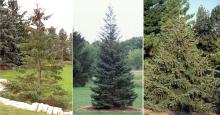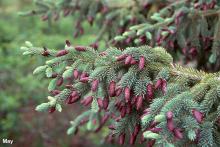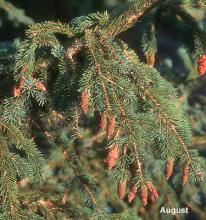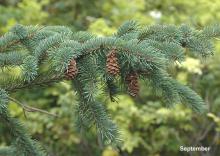Picea glauca 'Densata'
Common name:
Black Hills Spruce
Pronunciation:
PI-see-a GLAW-ka den-SA-ta
Family:
Pinaceae
Genus:
Synonyms:
Picea glauca var. densata
Type:
Conifer
Native to (or naturalized in) Oregon:
No
- Conifer, evergreen tree, 20-40 ft (6-12 m), symmetrical, compact, slow growing, . Needles may range from bright green to bluish green. Trees sometimes similar to P. glauca.
- Sun, light shade. Tough, withstands wind, heat, cold, drought, and crowding; can be used as hedge.
- Hardy to USDA Zone 2 Native to the Black Hills of southwestern South Dakota. The South Dakota State Tree.
-
It was originally named Picea glauca var. densata Bailey, but many authorities now designate it as cultivar, i.e., Picea glauca 'Densata', because its differences from the species are not sufficient to justify its classification as a botanical variety. In its small native habitat, the Black Hills area of South Dakota, it is commonly found growing at around 6000 ft (1830 m) in elevation. It typically grows rather slowly in a dense, symmetrical cone to 20-25(~6-7.5 m) tall, but over time may rise to 40-60 ft (14.5-18 m) or more. It is distinguished from the species by having
(1) smaller size with slower growth rate,
(2) denser habit,
(3) brighter green to blue-green needles and
(4) slightly shorter cones.
- By reputation in the horticulture industry, Black Hills spruce is a superior ornamental tree to the species (Missouri Botanical Garden).
- densata: compact, dense.




